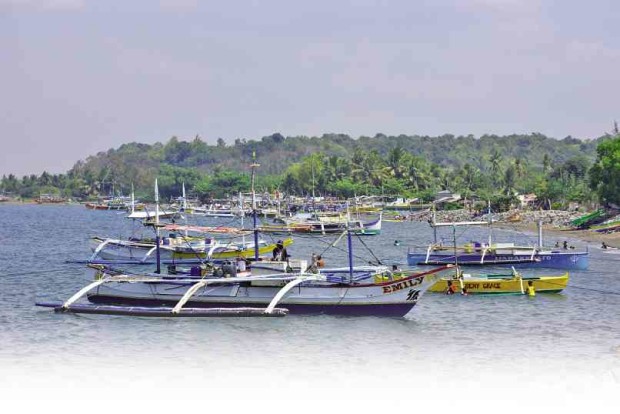
FISHERMEN’S boats are docked near the shore of Cato village in Infanta town, Pangasinan province. WILLIE LOMIBAO/INQUIRER NORTHERN LUZON
LINGAYEN, Pangasinan—As many as 650 people from two Pangasinan towns would need new jobs amid increased Chinese aggression in the Scarborough Shoal that followed the Permanent Court of Arbitration (PCA) ruling declaring China’s territorial claims in the West Philippine Sea to be baseless.
Chinese patrols in Scarborough prevented fishermen from the two towns from going near the shoal to fish as they had done for decades.
Hurt by the fishing ban are up to 600 residents of Infanta town and up to 50 residents of Dasol town, said Rhodyn Lochinvar Oro, Pangasinan disaster risk reduction and management officer.
Alternative livelihood
Oro said involved are 30 fishing boats from Barangay Cato in Infanta and 12 boats from Barangay Poblacion and Petal in Dasol.
Gov. Amado Espino III has formed a technical working group (TWG) to look for alternative livelihood programs for the fishermen.
On Monday in Pampanga province, Agriculture Secretary Emmanuel Piñol said the Department of Agriculture would soon distribute 100 fishing boats to Pangasinan fishermen hurt by the territorial dispute.
Dalisay Moya, Pangasinan agriculturist and TWG head, said she had scheduled a meeting with Infanta and Dasol fishermen to find out what livelihood projects would suit them.
Oro said there was also a need to augment initiatives by the Infanta government, which helped establish cooperatives for the fishermen, as well as livelihood projects for women with the help of a nongovernment organization.
According to a provincial government report, a task force needs to study “not only the economic and social impacts but also the safety and security of Pangasinenses over the long term and how to prepare them in case the situation at the West Philippine Sea worsens.”
Chinese patrols
So far, fishermen have steered clear of the shoal due to security concerns, the report said.
Chinese Coast Guard vessels at the shoal had become more aggressive in driving away fishermen after the PCA in The Hague ruled in favor of the Philippines over China.
Fishermen have been forced to work in “payao” (artificial reefs) “but it has been a big gamble when they go there [because] they are never sure if there are fish in the payao,” said Cato village chief Charlito Maniago.
Payao are made up of small bamboo rafts strapped with palm leaves to attract small fish that feed on plankton forming around the fronds. Bigger fish, like tuna, are in turn attracted by the small fish.
Oro said the Bureau of Fisheries and Aquatic Resources (BFAR) also trained fishermen on seaweed farming and breeding fingerlings.
Last year, BFAR Ilocos regional director Nestor Domenden, said the agency had installed payao within 15-kilometer municipal waters in the region’s western seaboard to keep fishermen away from the shoal and other remote fishing grounds.
He said 90 percent of fishing is done within the 15-km fishing area. He said at least 35 percent of the project is already finished.
BFAR also developed fish sanctuaries using artificial reefs, where fish could breed and lay eggs to replace those that fishermen catch. Gabriel Cardinoza, Inquirer Northern Luzon with a report from Tonette Orejas, Inquirer Central Luzon